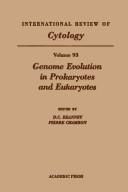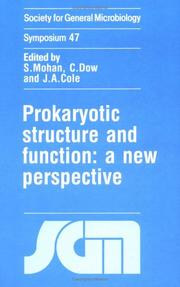| Listing 1 - 10 of 33 | << page >> |
Sort by
|
Book
ISBN: 0387307419 Year: 2006 Publisher: New York, NY : Springer New York : Imprint: Springer,
Abstract | Keywords | Export | Availability | Bookmark
 Loading...
Loading...Choose an application
- Reference Manager
- EndNote
- RefWorks (Direct export to RefWorks)
The first edition of The Prokaryotes, published in 1981, took a bold step to become the most comprehensive and authoritative encyclopedic handbook on prokaryotes. Another important step was taken with the second edition in 1992, when the chapters were organized on the basis of the molecular phylogeny as a rational, evolutionary basis for the taxonomy of the prokaryotes. By then, the two volumes of the first edition had expanded to four. With the decision to publish the handbook electronically, the third edition was the boldest step of all. The advantages were obvious and persuasive: essentially unlimited space, no restrictions on the use of color, and the inclusion of film and animated illustrations. Nevertheless, the affection for a printed handbook was highly underestimated and during the first 5 years of the continuously evolving online version, a growing demand for a new print edition was voiced by the scientific and corporate community. Thus, Springer is now publishing a third edition in printed form. In total, 7 volumes will make up this new fully revised and updated version. Compared to the second edition, this edition will contain 85% new contents, printed in color throughout. It will be ideally suited for research centers in academia and in the corporate world that need reliable and up-to-date information on the biology of the prokaryotic organisms.
Prokaryotes --- Biotechnology. --- Chemical engineering --- Genetic engineering --- Monera --- Procaryotae --- Procaryotes --- Prokaryonta --- Prokaryotae --- Prokaryotic protists --- Microorganisms --- Microbiology. --- Medical Microbiology. --- Microbial biology --- Biology --- Medical microbiology.
Book
ISBN: 3642301975 3642301967 3642301983 Year: 2014 Publisher: Berlin, Heidelberg : Springer Berlin Heidelberg : Imprint: Springer,
Abstract | Keywords | Export | Availability | Bookmark
 Loading...
Loading...Choose an application
- Reference Manager
- EndNote
- RefWorks (Direct export to RefWorks)
The Prokaryotes is a comprehensive, multi-authored, peer reviewed reference work on Bacteria and Archaea. This fourth edition of The Prokaryotes is organized to cover all taxonomic diversity, using the family level to delineate chapters. Different from other resources, this new Springer product includes not only taxonomy, but also prokaryotic biology and technology of taxa in a broad context. Technological aspects highlight the usefulness of prokaryotes in processes and products, including biocontrol agents and as genetics tools. The content of the expanded fourth edition is divided into two parts: Part 1 contains review chapters dealing with the most important general concepts in molecular, applied and general prokaryote biology; Part 2 describes the known properties of specific taxonomic groups. Two completely new sections have been added to Part 1: bacterial communities and human bacteriology. The bacterial communities section reflects the growing realization that studies on pure cultures of bacteria have led to an incomplete picture of the microbial world for two fundamental reasons: the vast majority of bacteria in soil, water and associated with biological tissues are currently not culturable, and that an understanding of microbial ecology requires knowledge on how different bacterial species interact with each other in their natural environment. The new section on human microbiology deals with bacteria associated with healthy humans and bacterial pathogenesis. Each of the major human diseases caused by bacteria is reviewed, from identifying the pathogens by classical clinical and non-culturing techniques to the biochemical mechanisms of the disease process. The 4th edition of The Prokaryotes is the most complete resource on the biology of prokaryotes.
Life sciences. --- Microbiology. --- Life Sciences. --- Microbial biology --- Biology --- Microorganisms --- Biosciences --- Sciences, Life --- Science --- Prokaryotes. --- Monera --- Procaryotae --- Procaryotes --- Prokaryonta --- Prokaryotae --- Prokaryotic protists
Book
ISBN: 3642390447 3642390439 3642390455 Year: 2014 Publisher: Berlin, Heidelberg : Springer Berlin Heidelberg : Imprint: Springer,
Abstract | Keywords | Export | Availability | Bookmark
 Loading...
Loading...Choose an application
- Reference Manager
- EndNote
- RefWorks (Direct export to RefWorks)
The Prokaryotes is a comprehensive, multi-authored, peer reviewed reference work on Bacteria and Achaea. This fourth edition of The Prokaryotes is organized to cover all taxonomic diversity, using the family level to delineate chapters. Different from other resources, this new Springer product includes not only taxonomy, but also prokaryotic biology and technology of taxa in a broad context. Technological aspects highlight the usefulness of prokaryotes in processes and products, including biocontrol agents and as genetics tools. The content of the expanded fourth edition is divided into two parts: Part 1 contains review chapters dealing with the most important general concepts in molecular, applied and general prokaryote biology; Part 2 describes the known properties of specific taxonomic groups. Two completely new sections have been added to Part 1: bacterial communities and human bacteriology. The bacterial communities section reflects the growing realization that studies on pure cultures of bacteria have led to an incomplete picture of the microbial world for two fundamental reasons: the vast majority of bacteria in soil, water and associated with biological tissues are currently not culturable, and that an understanding of microbial ecology requires knowledge on how different bacterial species interact with each other in their natural environment. The new section on human microbiology deals with bacteria associated with healthy humans and bacterial pathogenesis. Each of the major human diseases caused by bacteria is reviewed, from identifying the pathogens by classical clinical and non-culturing techniques to the biochemical mechanisms of the disease process. The 4th edition of The Prokaryotes is the most complete resource on the biology of prokaryotes. The following volumes are published consecutively within the 4th Edition: Prokaryotic Biology and Symbiotic Associations Prokaryotic Communities and Ecophysiology Prokaryotic Physiology and Biochemistry Applied Bacteriology and Biotechnology Human Microbiology Actinobacteria Firmicutes Alphaproteobacteria and Betaproteobacteria Gammaproteobacteria Deltaproteobacteria and Epsilonproteobacteria Other Major Lineages of Bacteria and the Archaea .
Life sciences. --- Microbiology. --- Life Sciences. --- Microbial biology --- Biology --- Microorganisms --- Biosciences --- Sciences, Life --- Science --- Prokaryotes. --- Monera --- Procaryotae --- Procaryotes --- Prokaryonta --- Prokaryotae --- Prokaryotic protists
Book
ISBN: 038730746X Year: 2006 Publisher: New York, NY : Springer New York : Imprint: Springer,
Abstract | Keywords | Export | Availability | Bookmark
 Loading...
Loading...Choose an application
- Reference Manager
- EndNote
- RefWorks (Direct export to RefWorks)
The first edition of The Prokaryotes, published in 1981, took a bold step to become the most comprehensive and authoritative encyclopedic handbook on prokaryotes. Another important step was taken with the second edition in 1992, when the chapters were organized on the basis of the molecular phylogeny as a rational, evolutionary basis for the taxonomy of the prokaryotes. By then, the two volumes of the first edition had expanded to four. With the decision to publish the handbook electronically, the third edition was the boldest step of all. The advantages were obvious and persuasive: essentially unlimited space, no restrictions on the use of color, and the inclusion of film and animated illustrations. Nevertheless, the affection for a printed handbook was highly underestimated and during the first 5 years of the continuously evolving online version, a growing demand for a new print edition was voiced by the scientific and corporate community. Thus, Springer is now publishing a third edition in printed form. In total, 7 volumes will make up this new fully revised and updated version. Compared to the second edition, this edition will contain 85% new contents, printed in color throughout. It will be ideally suited for research centers in academia and in the corporate world that need reliable and up-to-date information on the biology of the prokaryotic organisms.
Bacteria --- Prokaryotes --- Monera --- Procaryotae --- Procaryotes --- Prokaryonta --- Prokaryotae --- Prokaryotic protists --- Microorganisms --- Germs --- Microbes --- Microbiology. --- Medical Microbiology. --- Microbial biology --- Biology --- Prokaryotes. --- Medical microbiology.
Book
ISBN: 0387307478 Year: 2006 Publisher: New York, NY : Springer New York : Imprint: Springer,
Abstract | Keywords | Export | Availability | Bookmark
 Loading...
Loading...Choose an application
- Reference Manager
- EndNote
- RefWorks (Direct export to RefWorks)
The first edition of The Prokaryotes, published in 1981, took a bold step to become the most comprehensive and authoritative encyclopedic handbook on prokaryotes. Another important step was taken with the second edition in 1992, when the chapters were organized on the basis of the molecular phylogeny as a rational, evolutionary basis for the taxonomy of the prokaryotes. By then, the two volumes of the first edition had expanded to four. With the decision to publish the handbook electronically, the third edition was the boldest step of all. The advantages were obvious and persuasive: essentially unlimited space, no restrictions on the use of color, and the inclusion of film and animated illustrations. Nevertheless, the affection for a printed handbook was highly underestimated and during the first 5 years of the continuously evolving online version, a growing demand for a new print edition was voiced by the scientific and corporate community. Thus, Springer is now publishing a third edition in printed form. In total, 7 volumes will make up this new fully revised and updated version. Compared to the second edition, this edition will contain 85% new contents, printed in color throughout. It will be ideally suited for research centers in academia and in the corporate world that need reliable and up-to-date information on the biology of the prokaryotic organisms.
Prokaryotes --- Bacteria --- Monera --- Procaryotae --- Procaryotes --- Prokaryonta --- Prokaryotae --- Prokaryotic protists --- Microorganisms --- Bacterial systematics --- Bacterial taxonomy --- Bacteriology --- Microbiology. --- Medical Microbiology. --- Microbial biology --- Biology --- Bacteria. --- Medical microbiology.
Book
ISBN: 1860949835 9781860949838 1860949827 9781860949821 Year: 2008 Publisher: London Hackensack, NJ Imperial College Press Distributed by World Scientific Publishing
Abstract | Keywords | Export | Availability | Bookmark
 Loading...
Loading...Choose an application
- Reference Manager
- EndNote
- RefWorks (Direct export to RefWorks)
Over 500 prokaryotic genomes have been sequenced to date, and thousands more have been planned for the next few years. While these genomic sequence data provide unprecedented opportunities for biologists to study the world of prokaryotes, they also raise extremely challenging issues such as how to decode the rich information encoded in these genomes. This comprehensive volume includes a collection of cohesively written chapters on prokaryotic genomes, their organization and evolution, the information they encode, and the computational approaches needed to derive such information. A comparative
Bacterial genomes --- Computational biology --- Microbial genetics --- Prokaryotes --- Monera --- Procaryotae --- Procaryotes --- Prokaryonta --- Prokaryotae --- Prokaryotic protists --- Microorganisms --- Genetics --- Microbiology --- Biology --- Bioinformatics --- Bacterial genome --- Microbial genomes --- Data processing

ISBN: 0123644933 9780080586304 0080586309 9780123644930 9786611442798 1281442798 Year: 1985 Volume: 93 Publisher: Orlando ; London : Academic Press,
Abstract | Keywords | Export | Availability | Bookmark
 Loading...
Loading...Choose an application
- Reference Manager
- EndNote
- RefWorks (Direct export to RefWorks)
INTERNATIONAL REVIEW OF CYTOLOGY V93
General embryology. Developmental biology --- Molecular biology --- Eukaryotic cells. --- Prokaryotes. --- Evolution. --- Cytology. --- Biology --- Cells --- Cell biology --- Cellular biology --- Philosophy --- Creation --- Emergence (Philosophy) --- Teleology --- Microorganisms --- Monera --- Procaryotae --- Procaryotes --- Prokaryonta --- Prokaryotae --- Prokaryotic protists --- Protista --- Eucaryotic cells

ISBN: 0521415705 9780521415705 Year: 1992 Volume: 47 Publisher: Cambridge ; New York ; Sydney Cambridge University Press
Abstract | Keywords | Export | Availability | Bookmark
 Loading...
Loading...Choose an application
- Reference Manager
- EndNote
- RefWorks (Direct export to RefWorks)
Prokaryotes --- Prokaryotic Cells --- Bacteria --- Ultrastructure --- Congresses --- Physiology --- physiology --- cytology --- -Prokaryotes --- -Monera --- Procaryotae --- Procaryotes --- Prokaryonta --- Prokaryotae --- Prokaryotic protists --- Microorganisms --- cytology. --- physiology. --- -Congresses --- Congresses. --- -cytology. --- Prokaryotes - Ultrastructure - Congresses --- Prokaryotes - Physiology - Congresses --- Prokaryotic Cells - physiology - congresses --- Bacteria - cytology - congresses

ISBN: 9783540385776 3540385770 364207247X 9786610727414 1280727411 3540385827 Year: 2007 Publisher: Berlin ; New York : Springer,
Abstract | Keywords | Export | Availability | Bookmark
 Loading...
Loading...Choose an application
- Reference Manager
- EndNote
- RefWorks (Direct export to RefWorks)
Predatory Prokaryotes focuses on the ecology of predation at the microbial level. It aims to increase the awareness of the great possibilities that predation between microbes offer for studying and discussing basic ecological and general biological concepts. This volume contains chapters on the diversity, ecology and phylogeny of predatory prokaryotes, introducing models of predator–prey interactions between microorganisms and presenting analyses of the impact of predation in microbial systems. Laboratory work with Bdellovibrio-and-like organisms (BALOs), the most studied predatory bacteria, is presented through accounts of the cultivation and the molecular techniques used for studying BALOs. A first comparative analysis of different BALO genomes is also provided. Further chapters discuss the chemotactic, regulatory and sensory circuits of these ubiquitous predatory bacteria. Finally, the unique biochemicals used as building blocks and new proteins found in BALO cell walls are reviewed.
Prokaryotes. --- Prokaryotes --- Procaryotes --- Physiology. --- Bdellovibrio -- physiology. --- Prokaryotes -- Physiology. --- Prokaryotic Cells -- physiology. --- Prokaryote physiology --- Monera --- Procaryotae --- Prokaryonta --- Prokaryotae --- Prokaryotic protists --- Life sciences. --- Microbial ecology. --- Microbiology. --- Life Sciences. --- Microbial Ecology. --- Microorganisms --- Environmental microbiology --- Ecology --- Microbiology --- Microbial biology --- Biology
Book
ISBN: 3642301932 3642301940 3642301959 Year: 2013 Publisher: Berlin, Heidelberg : Springer Berlin Heidelberg : Imprint: Springer,
Abstract | Keywords | Export | Availability | Bookmark
 Loading...
Loading...Choose an application
- Reference Manager
- EndNote
- RefWorks (Direct export to RefWorks)
The Prokaryotes is a comprehensive, multi-authored, peer reviewed reference work on Bacteria and Achaea. This fourth edition of The Prokaryotes is organized to cover all taxonomic diversity, using the family level to delineate chapters. Different from other resources, this new Springer product includes not only taxonomy, but also prokaryotic biology and technology of taxa in a broad context. Technological aspects highlight the usefulness of prokaryotes in processes and products, including biocontrol agents and as genetics tools. The content of the expanded fourth edition is divided into two parts: Part 1 contains review chapters dealing with the most important general concepts in molecular, applied and general prokaryote biology; Part 2 describes the known properties of specific taxonomic groups. Two completely new sections have been added to Part 1: bacterial communities and human bacteriology. The bacterial communities section reflects the growing realization that studies on pure cultures of bacteria have led to an incomplete picture of the microbial world for two fundamental reasons: the vast majority of bacteria in soil, water and associated with biological tissues are currently not culturable, and that an understanding of microbial ecology requires knowledge on how different bacterial species interact with each other in their natural environment. The new section on human microbiology deals with bacteria associated with healthy humans and bacterial pathogenesis. Each of the major human diseases caused by bacteria is reviewed, from identifying the pathogens by classical clinical and non-culturing techniques to the biochemical mechanisms of the disease process. The 4th edition of The Prokaryotes is the most complete resource on the biology of prokaryotes. The following volumes are published consecutively within the 4th Edition: Prokaryotic Biology and Symbiotic Associations Prokaryotic Communities and Ecophysiology Prokaryotic Physiology and Biochemistry Applied Bacteriology and Biotechnology Human Microbiology Actinobacteria Firmicutes Alphaproteobacteria and Betaproteobacteria Gammaproteobacteria Deltaproteobacteria and Epsilonproteobacteria Other Major Lineages of Bacteria and the Archaea.
Prokaryotes --- Bacteria --- Microbiology --- Biology --- Health & Biological Sciences --- Microbiology & Immunology --- Microbial biology --- Germs --- Microbes --- Monera --- Procaryotae --- Procaryotes --- Prokaryonta --- Prokaryotae --- Prokaryotic protists --- Life sciences. --- Microbiology. --- Life Sciences. --- Microorganisms --- Biosciences --- Sciences, Life --- Science
| Listing 1 - 10 of 33 | << page >> |
Sort by
|

 Search
Search Feedback
Feedback About UniCat
About UniCat  Help
Help News
News